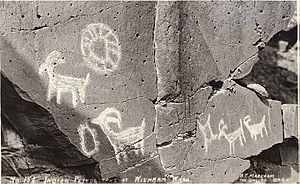Wasco-Wishram facts for kids
The Wasco-Wishram are two closely related Native American tribes. They originally lived along the Columbia River in Oregon. Today, many members of these tribes are part of the Confederated Tribes of Warm Springs. They live on the Warm Springs Indian Reservation in Oregon. Others are part of the Confederated Tribes and Bands of the Yakama Nation. They live on the Yakama Indian Reservation in Washington.
Contents
History of the Wasco-Wishram People
The Wasco and Wishram tribes are known as Plateau tribes. They shared many customs with tribes from the Northwest Coast. They lived along the banks of the Columbia River. Their homes were near a place called The Dalles. This area was a very important trading spot. The tribes used a large network to trade goods.
In the 1800s, the United States expanded its territory. This brought European diseases, which greatly reduced the Wasco and Wishram populations. By 1855, the United States made both tribes sign treaties. These treaties meant the tribes had to give up most of their lands. The treaties also created the Warm Springs Reservation for them.
The Wasco Tribe
The name Wasco comes from the word Wacq!ó. This word means "cup" or "small bowl." It refers to a special bowl-shaped rock near their main village. The Wasco traditionally lived on the south side of the Columbia River. In 1822, about 900 Wasco people were estimated to be living.
The Wasco were divided into three main groups. These included the Dalles Wasco, the Hood River Wasco, and the Cascades Indians. The Cascades Indians were also called Watlala. Their language was a bit different from other Wasco groups. Some people believe the Watlala might have been a separate tribe.
The Wishram Tribe
The Wishram tribe is also known by the names Tlakluit and Echeloot. They traditionally lived in permanent villages. These villages were located along the north banks of the Columbia River. In the 1700s, there were an estimated 1,500 Wishram people. By 1962, only 10 Wishram were counted in a Washington census.
Their main village was called Nixlúidix by its people. It was located on the Columbia River in Washington. This village is thought to be the largest ancient Chinook village site. Today, this site is part of Columbia Hills State Park. The village was near Celilo Falls. The name "Wishram" comes from neighboring tribes. They called the village Wɨ́šx̣am/Wɨ́šx̣aa, meaning "Spearfish." So, the people became known as Wɨ́šx̣amma, or "Wishram people."
Fishing Rights and Dams
The treaties signed in 1855 gave the Wasco-Wishram tribes special rights. They could fish "at all... usual and accustomed stations." This meant they could fish in their traditional spots.
Between 1938 and 1956, several large dams were built. These included the Bonneville Dam, Grand Coulee Dam, and The Dalles Dam. These dams caused great harm to the native fishing areas. The government paid money to the tribes for the loss of fish. However, this money could not replace the cultural and religious importance of fishing. Catching salmon and steelhead was very important to the tribes. In 1974, a major court case confirmed the rights of Northwest Coast tribes. It allowed them to fish as they had always done.
Wasco-Wishram Today
The Confederated Tribes of Warm Springs of Oregon has about 4,000 members. These members include Wasco, Walla Walla, Tenino, and Paiute people. About 200 of these 4,000 members are Wasco. Most Wishram people are part of the Confederated Tribes and Bands of the Yakama Nation in Washington state.
Language of the Tribes
The Wasco-Wishram language is part of the Upper Chinookan language family. This family is also called Kiksht. Today, only five elders on the Warm Springs Reservation speak the language fluently. The tribe has a language program. This program helps teach the language to tribal members of all ages. The goal is to help the language survive and grow.
Art and Craftsmanship
Both the Wasco and Wishram tribes are famous for their beautiful art. They are known for detailed wood carving, beadwork, and basket making. Pat Courtney Gold is a Wasco artist. She uses traditional Wasco-Wishram designs. She weaves these designs into modern baskets.



